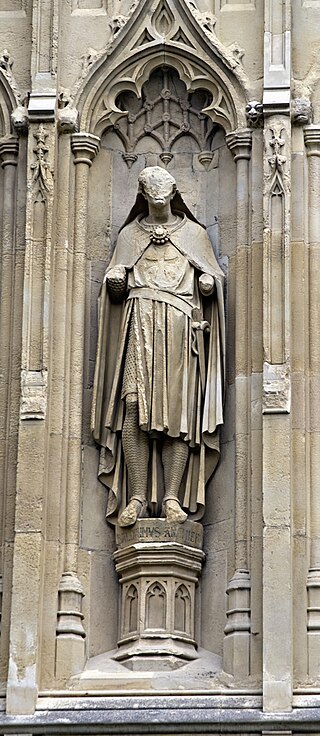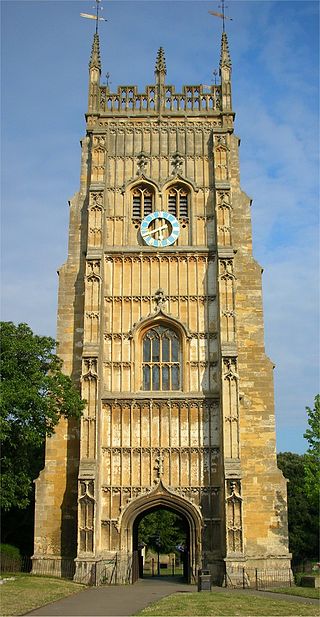Related Research Articles
Richard was a medieval Benedictine monk and Archbishop of Canterbury. Employed by Thomas Becket immediately before Becket's death, Richard arranged for Becket to be buried in Canterbury Cathedral and eventually succeeded Becket at Canterbury in a contentious election. Much of Richard's time as archbishop was spent in a dispute with Roger de Pont L'Evêque, the Archbishop of York over the primacy of England, and with St Augustine's Abbey in Canterbury over the archbishop's jurisdiction over the abbey. Richard had better relations with King Henry II of England than Becket had and was employed by the king on diplomatic affairs. Richard also had the trust of the papacy and served as a judge for it. Several of his questions to Pope Alexander III were collected into the Decretals, a collection of ecclesiastical laws, and his patronage of canon lawyers did much to advance the study of canon law in England.
Sigeric was the Archbishop of Canterbury from 990 to 994. Educated at Glastonbury Abbey, he became a monk there before becoming an abbot and then Bishop of Ramsbury before his elevation to the archbishopric. An account of his pilgrimage to Rome in 990 survives and is an important source for historians studying Rome during his lifetime.

Oswald of Worcester was Archbishop of York from 972 to his death in 992. He was of Danish ancestry, but brought up by his uncle, Oda of Canterbury, who sent him to France to the abbey of Fleury to become a monk. After a number of years at Fleury, Oswald returned to England at the request of his uncle, who died before Oswald returned. With his uncle's death, Oswald needed a patron and turned to another kinsman, Oskytel, who had recently become Archbishop of York. His activity for Oskytel attracted the notice of Archbishop Dunstan who had Oswald consecrated as Bishop of Worcester in 961. In 972, Oswald was promoted to the see of York, although he continued to hold Worcester also.

Baldwin of Forde or Ford was Archbishop of Canterbury between 1185 and 1190. The son of a clergyman, he studied canon law and theology at Bologna and was tutor to Pope Eugene III's nephew before returning to England to serve successive bishops of Exeter. After becoming a Cistercian monk he was named abbot of his monastery at Forde and subsequently elected to the episcopate at Worcester. Before becoming a bishop, he wrote theological works and sermons, some of which have survived.
Ælfric of Abingdon was a late 10th-century Archbishop of Canterbury. He previously held the offices of abbot of St Albans Abbey and Bishop of Ramsbury, as well as likely being the abbot of Abingdon Abbey. After his election to Canterbury, he continued to hold the bishopric of Ramsbury along with the archbishopric of Canterbury until his death in 1005. Ælfric may have altered the composition of Canterbury's cathedral chapter by changing the clergy serving in the cathedral from secular clergy to monks. In his will he left a ship to King Æthelred II of England as well as more ships to other legatees.
Savaric fitzGeldewin was an Englishman who became Bishop of Bath and Glastonbury in England. Related to his predecessor as well as to Emperor Henry VI, he was elected bishop on the insistence of his predecessor, who urged his election on the cathedral chapter of Bath. While bishop, Savaric spent many years attempting to annexe Glastonbury Abbey as part of his bishopric. Savaric also worked to secure the release of King Richard I of England from captivity, when the king was held by Emperor Henry VI.
Cyneweard was an Anglo-Saxon Bishop of Wells. He was a monk of Glastonbury Abbey before becoming abbot of Milton Abbey in 964. He was consecrated bishop of the Diocese of Wells in about 973 or 974, and died in office on 28 June 975. His death is mentioned in the short Old English poem "The Death of King Edgar", which occurs in the entry for 975 of two of the manuscripts of the Anglo-Saxon Chronicle.
Sigar was an Anglo-Saxon Bishop of Wells.
Hugh of Beaulieu was a medieval English Bishop of Carlisle.
Seffrid I, sometimes known as Seffrid Pelochin, was a medieval Bishop of Chichester.
Randulf of Evesham was a medieval Bishop of Worcester-elect and Abbot of Evesham.
The Chronicon Abbatiae de Evesham or Chronicle of the Abbey of Evesham, sometimes the Evesham Chronicle, is a medieval chronicle written at and about Evesham Abbey in Worcestershire in western England.
Æthelwig was an Abbot of Evesham before and during the Norman Conquest of England. Born sometime around 1010 or 1015, he was elected abbot in 1058. Known for his legal expertise, he administered estates for Ealdred, the Bishop of Worcester prior to his election as abbot. After his election, he appears to have acted as Ealdred's deputy, and was considered as a possible successor when Ealdred was elected Archbishop of York. Æthelwig worked during his abbacy to recover estates that had been lost to Evesham, as well as acquiring more estates.

Dominic of Evesham was a medieval prior of Evesham Abbey in England and writer of religious texts. Probably a native Englishman, there is some confusion about when he became a monk, but by 1104 he was at Evesham and by 1125 he held the office of prior. He is chiefly known for his religious works, including one on the miracles of the Virgin Mary that was an important source for later writings on the subject. Four of his works are still extant.
The Abbot of Evesham was the head of Evesham Abbey, a Benedictine monastery in Worcestershire founded in the Anglo-Saxon era of English history. The succession continued until the dissolution of the monastery in 1540.
Adam of Eynsham was a medieval English chronicler and writer. He was a monk and Abbot of Eynsham Abbey.
Roger Norreis was Abbot of Evesham in England. He was a controversial figure, installed in several offices against opposition. In his appointment to Evesham, he was accused of immoral behaviour and failing to follow monastic rules. In 1202, Norreis became embroiled in a dispute with his monks and his episcopal superior the Bishop of Worcester; litigation and argumentation lasted until his deposition in 1213. He was then appointed prior of a subsidiary monastic house of Evesham, but was deposed within months, then re-appointed to the office five years later.
Clarembald was a medieval Benedictine monk and abbot-elect of St Augustine's Abbey in Canterbury, Kent.
Walter, Abbot of Evesham or Walter de Cerisy, Gauthier de Cerisy was an 11th-century abbot and church leader in England under the Norman conquest. He is known from the Domesday Book and several legal documents.
Mannig or Manni, also called Wulfmær, was an English monk and artist who became Abbot of Evesham in 1044. After suffering from paralysis, he resigned in 1058.
References
- Boyle, Leonard E. (1983). "The Beginnings of Legal Studies at Oxford". Viator. 14: 107–132. doi:10.1484/J.VIATOR.2.301453.
- Gransden, Antonia (1974). Historical Writing in England c. 550-c. 1307 . Ithaca, NY: Cornell University Press. ISBN 0-8014-0770-2.
- Knowles, David (1976). The Monastic Order in England: A History of its Development from the Times of St. Dunstan to the Fourth Lateran Council, 940–1216 (Second reprint ed.). Cambridge, UK: Cambridge University Press. ISBN 0-521-05479-6.
- Knowles, David; London, Vera C. M.; Brooke, Christopher (2001). The Heads of Religious Houses, England and Wales, 940–1216 (Second ed.). Cambridge, UK: Cambridge University Press. ISBN 0-521-80452-3.